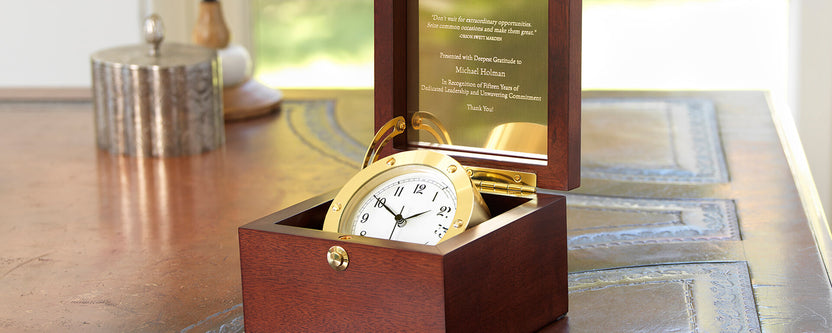Forging: Our Quest for Perfection
 At the Factory - Forgings Waiting to Be Polished
At the Factory - Forgings Waiting to Be Polished
“Forging lasts forever because it creates a brass that is durable, thick and can be finely refinished. And more importantly there are no imperfections,” said one of the company’s most knowledgeable executives, Vice President of Supply Chain and Materials Management Bruce Mauch. Mauch explained that where some competitors skimp on quality and durability, drawing clocks from sheet brass, Chelsea Clocks turns solid pieces of brass into the shapes of the world’s most impeccable keepers of time.
Throughout his almost 30 years with the company he has worked on several lines including manufacturing and engineering. It is the acknowledgment that he receives from the passerby that reaffirms the distinct craftsmanship of the clocks that serves as the source of his pride for the company and its product.
“When I tell people that I work for Chelsea Clocks and they say ‘Oh I love your clocks, I have one’ that response and to be part of the production of a great product gives me a lot of pride,” he said. He explained that forging is the reason why people have come to expect their clocks to live for generations. It was during the late 1950’s and 1960’s that the company opted to forge the brass instead of using the simpler method of casting. Only the 8.5” clocks were ceased for about 10 years during the 1980’s as the technology did not exist for it to be created from the forging method. Mauch explained that although casting still constructed a durable clock, forging eliminated the small flaws.
 A Technician Expertly Polishing a Forged Brass Case
A Technician Expertly Polishing a Forged Brass Case
“In the old days clock cases were created a using a mold or cavity,” he said. Heated brass in liquid form was poured into the cavity to form the clock’s case. That old method of casting caused pockets of air in the form of pinholes, or what seasoned clock makers call porosity. The ‘dimples’ in the product is where there is no metal, so although one could just “stick the cavity on the stand and make a mold,” the quality suffered he said. The method of forging instead begins with solid brass that is heated up to a malleable state. It is then placed in a metal die that imparts its desired shape. Then under extreme pressure the brass is smoothly and evenly converted to a clock case. A 1,500 ton steel press “hits the die and forces the metal to flow.” Mauch said one can visualize it as piece of clay being forced into a shaped cavity by a heavy weight. The result is a solid, evenly dense heavy brass with an unparalleled smoothness throughout. That also contributes to the quality of a clocks sound, such as the Ships Bell Clock’s distinct bell tone.









